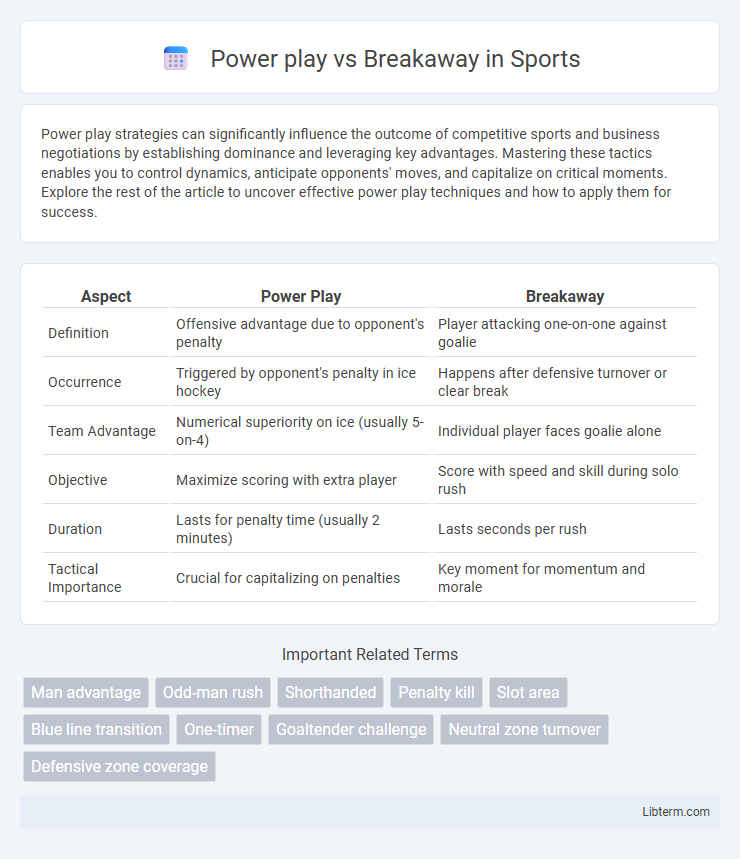Power play strategies can significantly influence the outcome of competitive sports and business negotiations by establishing dominance and leveraging key advantages. Mastering these tactics enables you to control dynamics, anticipate opponents' moves, and capitalize on critical moments. Explore the rest of the article to uncover effective power play techniques and how to apply them for success.
Table of Comparison
| Aspect | Power Play | Breakaway |
|---|---|---|
| Definition | Offensive advantage due to opponent's penalty | Player attacking one-on-one against goalie |
| Occurrence | Triggered by opponent's penalty in ice hockey | Happens after defensive turnover or clear break |
| Team Advantage | Numerical superiority on ice (usually 5-on-4) | Individual player faces goalie alone |
| Objective | Maximize scoring with extra player | Score with speed and skill during solo rush |
| Duration | Lasts for penalty time (usually 2 minutes) | Lasts seconds per rush |
| Tactical Importance | Crucial for capitalizing on penalties | Key moment for momentum and morale |
Power Play vs Breakaway: Defining the Concepts
Power play refers to a situation in sports, particularly hockey, where one team has a numerical advantage due to an opponent's penalty, increasing scoring opportunities. Breakaway occurs when a player gains uncontested control of the puck or ball ahead of all defenders, allowing a rapid and often decisive offensive move. Understanding these concepts highlights the strategic shift between exploiting penalized opponents in power plays versus utilizing speed and skill during breakaways.
Key Differences Between Power Plays and Breakaways
Power plays occur when one team has a numerical advantage due to an opponent's penalty, allowing for sustained offensive pressure and strategic puck control. Breakaways happen during even strength when a player gains clear, uncontested speed toward the goalie, creating a high-stakes scoring chance through one-on-one skill. The primary difference lies in the context and dynamics: power plays are team-based, sustained efforts exploiting manpower advantage, while breakaways are fast, individual situations requiring quick decision-making and precision.
The Tactical Importance of a Power Play
A power play in hockey provides a strategic advantage by creating numerical superiority, allowing the attacking team to control puck possession and set up high-quality scoring opportunities. Effective power play tactics focus on puck movement, player positioning, and exploiting gaps in the penalty-killing formation to maximize shot quality and scoring chances. Mastery of power play strategies significantly increases a team's probability of converting penalties into goals compared to breakaways, which rely more on individual skill and speed in isolated scenarios.
Anatomy of a Breakaway: One-on-One Intensity
The anatomy of a breakaway centers on the one-on-one intensity between the offensive player and the goalie, where speed, anticipation, and precision are crucial for success. The skater must rapidly close the gap, maintain control under pressure, and exploit the goaltender's weaknesses through deceptive shots or swift maneuvers. Unlike a power play, which relies on team coordination and numerical advantage, a breakaway demands individual skill and mental toughness in high-stakes, isolated scenarios.
Strategies for Success: Power Play Approaches
Power play strategies in hockey emphasize aggressive puck control and precise player positioning to maximize scoring chances during opponent penalties. Utilizing quick puck movement, effective face-offs, and creating traffic in front of the net disrupts the penalty kill and opens shooting lanes. Teams often deploy a strong point shot combined with net-front screens to capitalize on rebounds and deflections during power plays.
Breakaway Execution: Skills and Mindset
Breakaway execution demands exceptional puck control, precise timing, and quick decision-making to outmaneuver the goalie during high-pressure, one-on-one situations. Players must cultivate a confident mindset, maintaining composure and anticipating the goaltender's moves while exploiting open ice for optimal scoring chances. Mastery of breakaway skills enhances scoring efficiency beyond set plays like power plays by leveraging individual creativity and speed.
Defensive Responses: Power Play vs Breakaway
Defensive responses during a power play emphasize maintaining tight positional coverage and active stick checking to disrupt passing lanes, limiting the attacking team's scoring opportunities. In contrast, defending a breakaway requires quick, strategic gap control and precise body positioning to reduce the shooter's angles, forcing them into low-percentage shots. Goalkeepers also adjust their techniques, focusing on rapid lateral movements and anticipation to counter the increased one-on-one pressure inherent in breakaway situations.
Psychological Pressure in Power Plays and Breakaways
Power plays create intense psychological pressure on defending teams due to the numerical disadvantage, often leading to defensive mistakes and increased stress for penalty-killing players. Breakaways trigger immense mental focus and heightened anxiety for both the attacker, who must capitalize on a one-on-one scoring chance, and the goalie, responsible for a high-stakes save under pressure. These scenarios test players' composure, decision-making skills, and ability to perform under critical game moments.
Impact on Game Momentum: Power Play and Breakaway Effects
Power plays create sustained pressure by giving one team a numerical advantage, often leading to increased goal-scoring opportunities and shifting game momentum decisively in their favor. Breakaways generate sudden, high-stakes scoring chances that can instantly energize a team and dramatically alter the pace and intensity of the game. The contrasting dynamics of power plays and breakaways significantly influence momentum swings, with power plays fostering control and breakaways enabling swift momentum shifts.
Memorable Power Plays and Breakaways in Hockey History
Memorable power plays and breakaways have defined pivotal moments in hockey history, showcasing players' skill and strategy under pressure. Iconic power plays like the 1980 Miracle on Ice goal and Sidney Crosby's Golden Goal during the 2010 Olympics highlight the offensive advantage gained with a man advantage. Breakaways from legends like Wayne Gretzky and Pavel Bure demonstrate the thrilling one-on-one confrontations that can change the game's momentum instantly.
Power play Infographic

 libterm.com
libterm.com